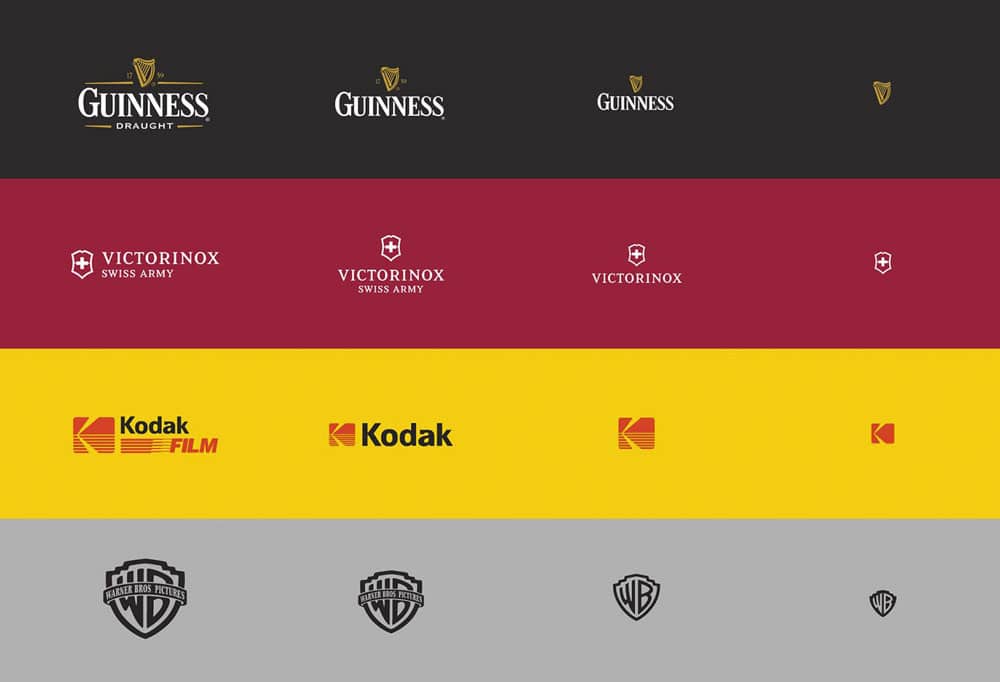Why Are Logos Important in Advertising?
Logos are one of the most vital elements of any advertising campaign. As the visual face of a brand, a logo conveys what a company or product is all about at a glance. But why exactly are logos so crucial for effective advertising? This comprehensive guide examines the key reasons.
Table of Contents
The Psychology Behind Logo Recognition

Before exploring the specific benefits logos offer advertisers, it helps to understand the psychology underpinning logo recognition. When you see a logo, what happens in your brain?
The Familiarity Principle
- The familiarity principle states that the more consumers encounter a stimulus, like a logo, the more they prefer and trust it.
- Familiar logos activate the striatum, the part of the brain registering reward responses. People feel intrinsic joy and positivity upon seeing a logo they know.
- Familiarity signals quality and safety to consumers. It unconsciously communicates: “This brand has been around a while, so that I can trust them.”
Ease of Processing
- Simple, recognisable logos are more manageable for our brains to process visually. This fluency offers comfort.
- Processing ease signals implicit safety and quality assumptions, much like familiarity does.
- The most straightforward logos to process feature clean lines, recognisable symbols, balanced layouts, and appealing colours. Examples include Apple, Nike, and Starbucks.
So, familiar and quickly processed logos provide a one-two punch of reward responses and positive unconscious associations. But why does this matter for advertising specifically?
The Direct Advertising Benefits Logos Provide

Let's explore the direct perks logos offer advertisers looking to enhance brand visibility and resonance with campaigns:
Instant Brand Recognition
- A logo serves as a visual shorthand for the brand. Upon seeing it, people immediately know which company or product is advertised.
- This allows brands to establish recognition without explaining themselves verbally in campaigns.
- Strong logo recognition means less text and context are required in ads. Negative space around a logo can heighten focus.
- Example: The Nike “Swoosh” alone often conveys an ad for Nike sneakers or apparel.
Versatility for Placement
- Highly recognisable logos can be resized, large and small, without losing effectiveness. Consider how tiny yet visible the Apple logo is on iPhones.
- This versatility allows logos to be placed in various advertising layouts and media.
- Logos work for TV spots, billboards, online ads, mobile ads, print ads, company swag—anything.
Keeping Campaigns On-Brand
- A consistent visual marker like a logo helps enforce cohesion in advertising campaigns across different forms of media.
- If a logo always appears, audiences know if a disparate TV commercial, billboard, and website ad comes from the same company.
- On-brand logo use builds familiarity with campaigns as coming from the same source.
Communication Without Words
- Non-verbal logos convey the intangible aspects of a brand's identity and personality with images and symbols.
- For example, the playful Google logo communicates the brand's whimsical identity. *Colors, symbols, typography choices, spacing, and other logo design elements speak volumes.
Grounding Abstractions
- Logos offer physical representations of abstract companies, products, and services.
- The Apple logo grounds the company's abstract brand attributes (innovation, creativity, problem-solving) into a tangible apple shape.
- Research shows that shapes and symbols aid human cognition of intangible concepts.
Rapid Eye-Catching
- Simple, vibrant logos grab attention rapidly amid clutter.
- Logos allow advertisers to capitalise on the crucial milliseconds that a potential consumer views an ad.
- Clean logos guide the eye quickly versus detailed images or text.
- Speedy recognition and positive familiarity response help make logos darling advertising elements.
Are Logos Important Across The Buyer's Journey?

So, we've covered why logos offer direct advertising advantages. Next, explore how they uniquely support branding and messaging as audiences travel through the buyer's journey.
The buyer's journey includes:
- Awareness: The phase where audiences get initially familiar with a product or company.
- Consideration: When learning about and comparing offerings to make decisions.
- Conversion: Making a purchase.
And post-purchase, there is:
- Loyalty: Ongoing engagement with brands consumers like and trust.
Here's how logos play a role across each phase:
Supporting Awareness Goals
- Because logos offer quick familiarity, they aid brand awareness from early exposure.
- Viewers feel they “know” a brand after seeing an easy-to-process logo repeated over touchpoints.
- Microsoft likely spent millions making their redesigned logo so clean and friendly for a reason!
Driving Consideration & Conversion
- In the consideration phase, logos help crystallise why one brand differs.
- The symbolic associations captured in a logo steer preferences.
- At conversion, buyers seek the rewarding dopamine hit of a now-familiar logo.
- The Amazon logo assuredly contributes to conversions thanks to the trust and familiarity built.
Post-Purchase Loyalty & Repurchasing
- After purchase, the cycle continues. Brand logo affinity grows with each exposure.
- Positive logo exposure after buying trains buyers that this brand satisfies their needs.
- When they next seek to make another purchase, logo familiarity eases re-buying.
- The classic Coca-Cola logo plays a role in why people repurchase endlessly.
So, logos offer advantages across each touchpoint, moving buyers from unawareness to loyal brand devotees who keep returning to purchase.
Additional Indirect Benefits: Credibility, Consistency & Costs
Beyond direct advertising and buyer journey benefits, logos also offer crucial credibility signalling and consistency across campaigns. Plus, they help control production costs:
Credibility Signals
- Simple, professional logos lend credibility by signalling competence.
- Assures audiences that real people back this brand and can deliver on promises.
- Messy, amateur logos erode trust and make consumers feel uncertain about quality.
- Consider how a medical company with an unprofessional logo would struggle to gain patients' confidence.
Consistent Branding Over Time
- Maintaining a logo and ad campaigns over the years builds equity and loyalty.
- Consistency signals committed identity instead of short-lived trend-chasing.
- Brands like Coca-Cola honour and use their logos across decades.
Cost Controls
- Reusing logos instead of commissioning new visual assets saves on production budgets.
- Easy to reuse digital logo files avoids shooting new ones.
- Creates marketer production efficiency.
- Compare creating 50 print ads with unique lead images each time versus placing the same polished logo across 50 ads.
So, in addition to direct advertising tie-ins, logos offer powerful peripheral signals influencing audience perceptions over time.
Logo Design Best Practices

Given how vital logos are for advertising success across the buyer journey, what makes for effective logo design? Follow these best practices:
Simplicity Rules
- The most recognisable logos are simple in layout and elements used. Complex logos fail.
- Avoid cluttered details that are difficult to shrink or process fast mentally.
- Remember—symbols serve as visual mental shorthand at a glance.
Use Timeless Over Trendy
- Trendy logos may grab short-term attention but offer less longevity.
- Classic logos enduring over decades project commitment and substance.
- Examples include Disney, Levi Strauss, Converse, Chanel, and Ford.
Ownable Concepts Win
- Strive for logos that are flexibly recognisable in various sizes and contexts.
- Consistent building through repetition drives mental ownership for brands.
- The Nike Swoosh proves broadly ownable—from shoes to golf balls to apparel.
Balance Creative Flair
- Logos succeeding feature creative flair expressing brand identity within constraints.
- The Twitter bird captures fluid chatter perfectly but avoids needless details.
- The Wendy's pigtails inject personality but allow scalability in other contexts.
Get these key elements right—simplicity, timelessness, ownability, creativity—and your logo will serve your advertising efforts well across touchpoints.
7 Statistics On Logo Importance
Still not entirely convinced about the power of logos in advertising? These statistics convey their formidable influence:
- 90% of consumers can precisely recall seeing a Coca-Cola advertisement, with the logo's red and white colours positively impacting feelings and memories.
- 48.7% of young adult consumers feel logos help them identify quality clothing brands versus trendy unknown labels.
- 62% of shoppers check whether an unfamiliar company has a nicely designed logo before trusting their website, seeking it as a credibility signal.
- 89% of leading brand managers rank logo recognition as the top metric they track above sales numbers, social media chatter, or reviews.
- Controlling for price and quality, test groups overwhelmingly choose packages with familiar brand logos versus generic labels—63% over store brand options.
- On average, improving logo familiarity lifts conversion rates by 42%.
- Simple logos boost name recognition for new brands by 71% over complicated logo designs.
Reviewing these statistics confirms logos are no mere accessories. How brands architect and employ logos significantly guides perceptions, trust gains, and buyer behaviour.
Key Takeaways On Logo Importance
While the above explored the research and rationale extensively, it helps to summarise why logos offer an indispensable element for advertising:
- They activate powerful psychological recognition effects by using consistent branding symbols.
- Logos convey intangible brand attributes into tangible designs that audiences can easily conceptualise.
- Instant recognition provides platforms to insert minimalist yet compelling advertising creative.
- Clean, professional logos signal competence and frame buyer interpretations.
- Over long time horizons, committed logo application accelerates familiarity and preference/trust gains.
For these reasons and more, advertisers dedicate enormous efforts to designing, safeguarding, and repeatedly displaying logos—answering why they remain elemental for effective branding and campaigning. But a logo also represents a promise to communicate what audiences should expect from the experience using a product or platform. Honouring what a symbol stands for is crucial to winning initial purchases and establishing buyer loyalty.
Conclusion
Logos distil the core identity of brands into brief but essential visual marks. In advertising contexts ranging from large format billboards to tiny mobile screens, symbols convey recognisable meaning instantly while seated comfortably in our unconscious.
The psychology of familiarity means that each exposure to a trusted logo stimulates innate reward responses. Meanwhile, the symbols, colours, and aesthetic choices made in construction speak volumes, helping guide consumer sentiment.
Great advertising executions feature logos prominently because of these benefits. Logos offer the ultimate visual shortcut—signalling credibility, competence, and emotional connection in the blink of an eye across collaterals, from websites to clothing. For these reasons, logos warrant advertising spotlighting, strategic design blueprints to maximise impressions over campaigns, and commitment to consistency in application over time.
While surface-level visual marketing gimmicks come and go, logos endure the test of time—exactly why no advertising plan hoping to establish awareness, replicate sales, and foster loyalty can ignore a logo's importance.
FAQs
What are the three key reasons logos matter for advertising?
Rapid recall and recognition upon seeing them
Embedding brand personality characteristics into tangible symbols
Signals of credibility and competence to attract conversions
Do simple or complex logos perform better?
Simple yet distinctive logos almost always outperform complex designs. Clean logos are more easily processed mentally, build recognition faster, work across contexts, and feel more trustworthy.
Can I create my logo once and be done?
Effective brand stewardship requires revisiting logos over time to assess if they still resonate with audiences and convey the brand properly, given societal changes. Periodic refinement prevents outdated designs.
What goes into an effective logo?
Simplicity conveys the brand identity.
Original yet versatile visual symbols reinforce patterns of familiarity and ownership for audiences.
Creative artistry produces a unique, compelling aesthetic.
Do logos only matter for big brands spending a lot on advertising?
While logos hold incredible importance for global brands investing considerable sums in advertising, they prove equally vital for small companies. Competent symbols signal legitimacy to attain those early wins with credibility that establishes foundations for future growth. Limited advertising budgets make logos even more essential, providing something memorable and distinctive to anchor things either visually or conceptually while short on resources. Logos' ability to signal “we mean business” makes them universally important to multinational corporations and bootstrapped startups seeking initial traction.
